Arthur Lydiard invented jogging. The method of building up physical fitness by gradually increasing stamina is a simple one, used by millions of men and women worldwide as part of their everyday health and fitness regime. It was used to train New Zealand’s greatest track athletes, and helped propel New Zealand to the top of world middle-distance running.
Arthur Lydiard was born in 1917, in Auckland. He was educated at Mt Albert Grammar School and later trained as a shoemaker. Like many young New Zealand men, he was a keen schoolboy rugby player and continued to play into his 20s. He also enjoyed swimming and believed he was fit merely because he participated in physical activities. He never trained in a formal or organised way.

Arthur Lydiard Permission Arthur Lydiard, Run The Lydiard Way
But by the age of 27 his metabolism was naturally slowing and he could feel himself getting fat and lazy. A six-mile run with a friend who was a disciplined athlete proved to Lydiard that his fitness was on the wane. He described the feeling in the 1983 book Jogging with Lydiard:
“My pulse rate rose rapidly. I blew hard and gasped for air. My lungs and throat felt like they had been scorched. My legs were like rubber. My whole body felt the effects of the run and the effort expended to get me to the end of it.”
He speculated as to how many other first time runners identified with this feeling. His interest had been ignited. He wanted to know how to improve his fitness. He wanted to be in shape for the rest of his life. In looking for answers, Lydiard would change the way the world got fit.
Using Himself as a Test Subject
Lydiard had watched local runners of the day training, but that was discouraging. Their philosophy was ‘no pain, no gain’ and they sped around the tracks at top speed until they collapsed. Realising his need to get fit, he tried this technique a few times but it was too difficult, too disheartening. He decided to experiment.
Lydiard was a thorough and logical man; he didn’t have unrealistic expectations of himself, but he wanted to improve, and through slowly evolving patterns he gradually defined a basic theory:
“…that long, even-pace running at a strong speed produced increased strength and endurance – even when it is continued to the point of collapse – and was beneficial, not harmful, to regular competition.”
This is the essence of jogging.
From his fateful six mile run, Lydiard started a concerted training schedule. Within a few months he was covering up to 15 miles a day, but his natural tenacity and curiosity forced him to go further. His training technique came straight from his own imagination and he wanted to test it against other athletes. At the age of 27, when many athletes were preparing to retire, he started competitive running.
He began with one to three mile races, continuing to further refine his training and increase the distances he was running. He became a provincial cross-country representative and his training frequently consisted of runs of up to 50km. Getting older but also fitter: he set his sights on the marathon.
He soon discovered his marathon training was improving his time over shorter distances: a revelation that was to transform New Zealand runners into the best in the world.
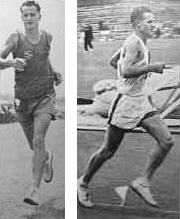
Lydiard wins the 1951 Auckland Marathon and the 1953 New Zealand Marathon Permission Arthur Lydiard
Super Coach
By the start of the 1950s, Lydiard was New Zealand’s top marathon runner. He competed in the 1950 Empire Games (finishing 13th, a placing he described as “poor”) and took the national title in 1953 and 1955.
The success of this more mature athlete had attracted attention from younger runners around Auckland. The first was Lawrie King. He had been running with Lydiard for two years and usually struggling behind the older man. King’s victory in a provincial championship mile race, where he led from the first lap and won by 80 metres, set Lydiard on course to be an unwitting coach.
King went on to be a national cross-country champion and six-mile record holder, as well as a 1954 Empire Games representative.
The group of runners, at first informal, included some of the greatest of all New Zealand track athletes: Barry Magee, Ray Puckett, Jeff Julian, Murray Halberg, John Davies, Bill Baillie and Peter Snell.
This was not an official ‘team’ selected from the country’s top athletes; it was a group of promising Aucklanders, members of the Owairaka Harriers and Lynndale club, who enjoyed running together.
Lydiard became more than their mentor, he didn’t so much push them, as force them to push themselves. The training runs he initiated were tough, they had to be. He saw the potential in his athletes, potential that perhaps wouldn’t have been released by a softer coach. As Peter Snell describes in his book No Bugles No Drums:
“I remember getting into Hendon Avenue, very close and yet so far from home. My legs were too sore to even walk and I draped myself over a fence and told myself I was going to make it at all costs. In that company, I wasn’t going to let anyone down, least of all myself.”
Of course the exertion had a purpose. Lydiard knew his runners well. In 1953 (only a year after they met), he predicted Murray Halberg would be the greatest middle distance runner in New Zealand. A year later, he made similar comments about Peter Snell. In 1978, with the benefit of hindsight, athletics journalist and co-author of Run – the Lydiard Way, Garth Gilmour, would say of Snell that he was “probably the most brilliant runner the world has ever seen, John Walker and Filbert Bayi included”. In the interim, Lydiard’s predictions would be absolutely demonstrated on the international stage.
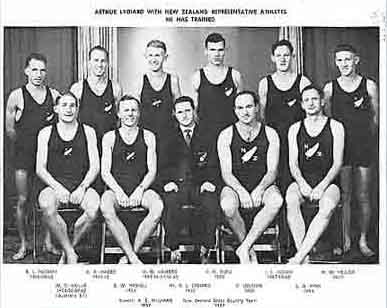
Click to Enlarge Arthur Lydiard with NZ Representative Athletes he has trained, 1957. Permission Arthur Lydiard, Athletic Training Schedule
Rome 1960
Five athletes competing at the 1960 Rome Olympics had been trained by Arthur Lydiard. This fact was recognised in New Zealand and he was well known to the general public, but he was not part of the official coaching staff and it was doubtful that he could travel to Rome with the team.
In No Bugles No Drums, Peter Snell blames the near-sightedness of the athletics administrators of the day who, he says, were out of touch with what the athletes needed:
“The men that decide these matters are so far removed from the practical side of the sport, that they cannot comprehend the value of the correct mental attitude in competition at levels as high as the Olympics.”
The athletes and the country knew how important it was to have Lydiard there, but the administrators wouldn’t budge. In the end a public appeal was launched, the money was quickly raised, and Lydiard attended the 1960 Olympics as an “independently travelling unofficial coach”.
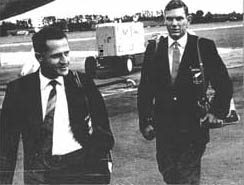
Arthur Lydiard and Peter Snell on the way to Rome 1960. Copyright The Herald, Auckland
On a hot September day in Rome, within the space of one hour, Peter Snell took Gold in the 800 metres (a new Olympic record) and Murray Halberg won Gold in the 5000 metres. There have been many great moments in New Zealand sport, but that effort is arguably New Zealand’s finest. The two athletes were instantly stars on the global stage and Lydiard, unofficial though he might have been, had become the world’s most respected athletics coach.
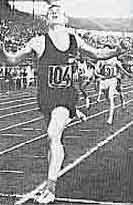
Peter Snell, Olympic champion and record holder. Permission Arthur Lydiard, Athletic Training Schedule
The New Zealand administrators could no longer ignore him, and for the next few years he continued to take New Zealand athletes to the top of world running. Snell was his most famous pupil and was the dominant force in world middle distance running in the early 1960s. His success at the Rome Olympics was followed two years later when he ran an incredible 3 minute 54.4 second mile on a grass track in Wanganui. One week later, he broke the world records for the 800 metres and the 800 yards. Also in 1962, he broke the world record for the indoor 880 and 1000 yards. He comfortably won the mile and the 880 yards (with a new Games record) at the 1962 Empire Games in Perth.
Fitness For The World
At the 1964 Olympics, in Tokyo, Snell broke his own Olympic record for the 800 metres and won the 1500 metres (fellow New Zealander John Davies took the Bronze). He finished off 1964, and his career on the track, by breaking his own mile world record with a time of 3 minutes 54.1 seconds. Three events, three Golds.
By the 1964 Olympics, Lydiard had achieved ‘official’ status and was the coach of the New Zealand athletics team.
When Lydiard first started training, his ideas were ignored at best and considered dangerous by many. The question was asked “how will a 400m runner benefit from running 15 miles?” Lydiard couldn’t give an answer in physiological terms, but he knew it worked and by the mid-1960s the rest of the world knew it too. In his career he coached the Venezuelan, the Finnish and the Mexican teams.
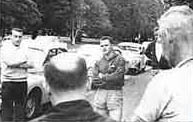
Arthur Lydiard gives a pre-run pep talk c. 1965 Permission Arthur Lydiard, Jogging with Arthur Lydiard
In February 1999, a group of athletes who had been coached by Lydiard threw their weight behind a campaign to have him knighted. Lydiard had already been awarded an OBE in 1962 and was made a Member of the Order of New Zealand (an honour regarded as higher than Knighthood), in 1990.
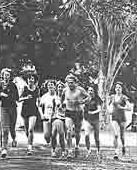
Arthur Lydiard with young proteges c. 1977 Permission Arthur Lydiard, Run The Lydiard Way
Dick Quax commented that Lydiard, besides training great athletes to perform at their best, had also taught the rest of the world better fitness and health practices.
“We recognise all the great surgeons who are talented people and do a marvellous job. But they’re the ambulance at the bottom of the cliff. What Arthur did was get people out doing light jogging for their health and you can’t put a figure on how many lives that has saved.”
When Lydiard started speaking about the virtues of mild to vigorous exercise for ordinary health, doctors were still prescribing bed rest for recovering heart patients. Today, exercise as part of recuperation is routine. The jogging phenomenon has swept the world, beyond fad and fashion, to become a lifestyle choice for millions of people. The information on Lydiard at the New Zealand Sports Hall of Fame conveys his importance to health, fitness and excellence:
“Like none other, Arthur Lydiard’s philosophy of running touches everyone that pulls on a pair of running shoes. He devised the principles of training employed by leading coaches and athletes all around the world, in track and field and many other sporting spheres; he invented the simple exercise of jogging which has infected millions with its benign bug.”
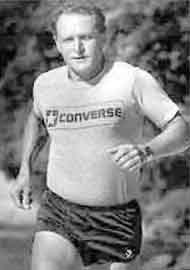
Permission Athletics New Zealand
In the Runners’ World (magazine) Millennium issue, Lydiard was named one of the five influential figures of the century in running.
With literally millions of trainers everyday pounding the pavements of the planet, Arthur Lydiard’s influence on personal health and fitness reverberates all over the world. His influence on competitive athletics is just as indelible.
In December 2004, after giving a lecture in Texas on athletics, Lydiard put his feet up and was apparently watching television in his hotel room when he had a heart attack. He died at the age of 87.
Sources
Web References:
Books written by, or about, Arthur Lydiard:
http://www.nzbooks.com
[accessed January 2000]
For profile of Lydiard as a member of the New Zealand Sports Hall of Fame:
http://www.athletics.org.nz/lydiard.html
[accessed January 2000]
Page on the Lydiard method on US running site:
http://www.fitnesssports.com/lyd_clinic_guide/lydpg2.html
[accessed February 2002]
Salute to Lydiard on ‘Traingain’ site:
“I doubt whether any coach will ever have more impact on the training practices of endurance athletes than this New Zealander.”
http://www.sportsci.org/news/traingain/lydiard.html
[accessed February 2002]
Books:
Lydiard, Arthur. and Gilmour, Garth. (1983) Jogging with Lydiard, Hodder and Stoughton, New Zealand
Gilmour, Garth. (1978) Run – the Lydiard Way, Hodder and Stoughton, New Zealand
Tayler, Dick. and Spencer, Jolly. (1975) Golds Aren’t Easy, John McIndoe, New Zealand
Gilmour, Garth. (1965) Run for your Life – Jogging with Arthur Lydiard, Minerva Bookshop Limited, New Zealand
Gilmour, Garth. (1965) No Bugles No Drums, Minerva Bookshop Limited, New Zealand
Articles:
Wischnia, Bob. (2000) “Spirits Who Led The Way”, Runner’s World, January
Hinton, Marc. (1999) “Stars back call for Lydiard’s knighthood”, Sunday Star Times, February 21
Warwick, Roger. (1996) “Great feats began from suburban home”, The Evening Post, July 29














Why do you have to put that he had a heart attack? This small, seemingly insignificant statement completely undermines the above discussion of running for health and insinuates that jogging does not in fact lead to any health benefits.
Dear Mr Lydiard, I just thought about using your principles of training now. I never even of just using single runs per day that add up to 13-20 miles. I didn't think my body could handle it. I always use to just do double runs, do you think that's still good from time to time? Yours truly, Travis Tate Student Northport, New York, USA